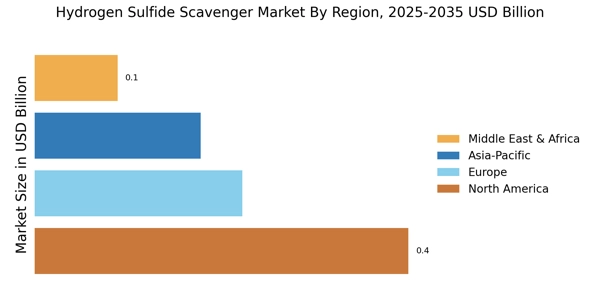The Hydrogen Sulfide Scavenger Market is currently characterized by a dynamic competitive landscape, driven by increasing demand for effective solutions in oil and gas, wastewater treatment, and various industrial applications. Key players such as Baker Hughes (US), Schlumberger (US), and Clariant (CH) are strategically positioned to leverage their technological expertise and extensive distribution networks. Baker Hughes (US) focuses on innovation through the development of advanced scavenger formulations, while Schlumberger (US) emphasizes digital transformation to enhance operational efficiency. Clariant (CH) is actively pursuing regional expansion, particularly in emerging markets, which collectively shapes a competitive environment that is both collaborative and competitive, fostering innovation and responsiveness to market needs.
In terms of business tactics, companies are increasingly localizing manufacturing and optimizing supply chains to enhance responsiveness and reduce costs. The market structure appears moderately fragmented, with several players vying for market share, yet the influence of major companies remains substantial. This competitive structure allows for a diverse range of products and services, catering to various customer needs while also fostering innovation through competition.
In August 2025, Baker Hughes (US) announced a strategic partnership with a leading technology firm to develop a next-generation hydrogen sulfide scavenger that utilizes AI for real-time monitoring and optimization. This move is significant as it not only enhances Baker Hughes' product offerings but also positions the company at the forefront of technological advancement in the market, potentially setting new standards for efficiency and effectiveness in H2S management.
In July 2025, Schlumberger (US) launched a new digital platform aimed at integrating its hydrogen sulfide scavenger solutions with predictive analytics tools. This initiative is crucial as it allows clients to anticipate H2S levels and adjust their operations accordingly, thereby minimizing risks and enhancing safety. The integration of digital tools into traditional chemical solutions reflects a broader trend towards digitalization in the industry, which is likely to reshape operational practices.
In September 2025, Clariant (CH) expanded its production capabilities in Asia by opening a new facility dedicated to the manufacturing of hydrogen sulfide scavengers. This expansion is indicative of Clariant's commitment to meeting the growing demand in the region and underscores the importance of local production in enhancing supply chain reliability. Such strategic moves not only bolster Clariant's market presence but also contribute to a more resilient supply chain in the face of global uncertainties.
As of October 2025, current competitive trends in the Hydrogen Sulfide Scavenger Market are increasingly defined by digitalization, sustainability, and the integration of advanced technologies such as AI. Strategic alliances among key players are shaping the landscape, fostering innovation and collaboration. Looking ahead, it appears that competitive differentiation will evolve from traditional price-based competition to a focus on innovation, technological advancements, and supply chain reliability, suggesting a transformative shift in how companies position themselves in the market.


















Leave a Comment